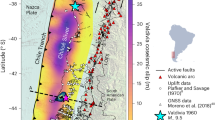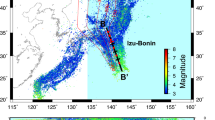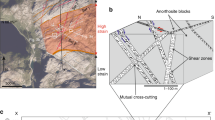Abstract
Subduction zones produce the largest earthquakes. Over the past two decades, space geodesy has revolutionized our view of crustal deformation between consecutive earthquakes. The short time span of modern measurements necessitates comparative studies of subduction zones that are at different stages of the deformation cycle. Piecing together geodetic ‘snapshots’ from different subduction zones leads to a unifying picture in which the deformation is controlled by both the short-term (years) and long-term (decades and centuries) viscous behaviour of the mantle. Traditional views based on elastic models, such as coseismic deformation being a mirror image of interseismic deformation, are being thoroughly revised.
This is a preview of subscription content, access via your institution
Access options
Subscribe to this journal
Receive 51 print issues and online access
$199.00 per year
only $3.90 per issue
Buy this article
- Purchase on Springer Link
- Instant access to full article PDF
Prices may be subject to local taxes which are calculated during checkout






Similar content being viewed by others
References
Elsasser, W. M. in The Application of Modern Physics to the Earth and Planetary Interiors (ed. Runcorn, S. K.) 223–246 (John Wiley, 1969)
Bott, M. H. P. & Dean, D. S. Stress diffusion from plate boundaries. Nature 243, 339–341 (1973)
Nur, A. & Mavko, G. Postseismic viscoelastic rebound. Science 183, 204–206 (1974)
Schubert, G., Turcotte, D. L. & Olsen, P. Mantle Convection in the Earth and Planets (Cambridge University Press, 2001)This book provides a comprehensive review of mantle rheology, Earth structure, theory of mantle convection, and fundamental questions to be addressed by the study of geodynamics.
Cohen, S. Numerical models of crustal deformation in seismic zones. Adv. Geophys. 41, 133–231 (1999)
Thatcher, W. & Rundle, J. B. A viscoelastic coupling model for the cyclic deformation due to periodically repeated earthquakes at subduction zones. J. Geophys. Res. 89, 7631–7640 (1984)This paper explains century-long levelling data from southwest Japan in terms of earthquake-cycle deformation and discusses short-term versus long-term postseismic deformation.
Matsu’ura, M. & Sato, T. A dislocation model for the earthquake cycle at convergent plate boundaries. Geophys. J. Int. 96, 23–32 (1989)
Wang, K. in The Seismogenic Zone of Subduction Thrust Faults (eds Dixon, T. H. & Moore, J. C.) 540–574 (Columbia University Press, 2007)
Savage, J. C. & Thatcher, W. Interseismic deformation at the Nankai Trough, Japan, subduction zone. J. Geophys. Res. 97, 11117–11135 (1992)
Wang, K., He, J., Dragert, H. & James, T. S. Three-dimensional viscoelastic interseismic deformation model for the Cascadia subduction zone. Earth Planets Space 53, 295–306 (2001)
Márquez Azúa, B., DeMets, C. & Masterlark, T. Strong interseismic coupling, fault afterslip, and viscoelastic flow before and after the Oct. 9, 1995 Jalisco-Colima earthquake: continuous GPS measurements from Colima, Mexico. Geophys. Res. Lett. 29, 1281 (2002)
Suito, H. & Freymueller, J. T. A viscoelastic and afterslip postseismic deformation model for the 1964 Alaska earthquake. J. Geophys. Res. 114, B11404 (2009)
Ali, S. T. & Freed, A. M. Contemporary deformation and stressing rates in Southern Alaska. Geophys. J. Int. 183, 557–571 (2010)
Moreno, M. S. et al. Heterogeneous plate locking in the South–Central Chile subduction zone: building up the next great earthquake. Earth Planet. Sci. Lett. 305, 413–424 (2011)
Wang, K., Wells, R., Mazzotti, S., Hyndman, R. D. & Sagiya, T. A revised dislocation model of interseismic deformation of the Cascadia subduction zone. J. Geophys. Res. 108 (B1). 2026 (2003)
McCaffrey, R. et al. Fault locking, block rotation and crustal deformation in the Pacific Northwest. Geophys. J. Int. 169, 1315–1340 (2007)
Wang, K. et al. Crustal motion in the zone of the 1960 Chile earthquake: detangling earthquake-cycle deformation and forearc-sliver translation. Geochem. Geophys. Geosyst. 8, Q10010 (2007)
Khazaradze, G. et al. Prolonged post-seismic deformation of the 1960 great Chile earthquake and implications for mantle rheology. Geophys. Res. Lett. 29, 2050 (2002)
Freymueller, J. T. et al. in Active Tectonics and Seismic Potential of Alaska (eds Freymueller, J. T., Haeussler, P. J., Wesson, R. L. & Ekstrom, G.) Geophys. Monogr. Ser. 179 1–42 (American Geophysical Union, 2008)
Pollitz, F., Banerjee, P., Grijalva, K., Nagarajan, B. & Burgmann, R. Effect of 3-D viscoelastic structure on post-seismic relaxation from the 2004 M = 9.2 Sumatra earthquake. Geophys. J. Int. 173, 189–204 (2008)
Shearer, P. & Bürgmann, R. Lessons learned from the 2004 Sumatra-Andaman megathrust rupture. Annu. Rev. Earth Planet. Sci. 38, 103–131 (2010)This review of the study of the 2004 Sumatra earthquake shows how geology, seismology, and space geodesy can be combined to investigate coseismic and postseismic deformation and tsunami processes.
Grijalva, K. A., Bürgmann, R. & Banerjee, P. Using postseismic geodetic data to constrain the Sunda downdip transition zone. Eos (Fall Meet. Suppl. ) 90 (52), abstr. T13E–01. (2009)
Weertman, J. & Weertman, J. R. High temperature creep of rock and mantle viscosity. Annu. Rev. Earth Planet. Sci. 3, 293–315 (1975)
Peltier, W. R., Wu, P. & Yuen, D. A. in Anelasticity in the Earth (eds Stacey, F. D., Paterson, M. S. & Nicolas, A.) Geodynamics Ser. 4 59–77 (American Geophysical Union, 1981)
Mitrovica, J. X. Haskell [1935] revisited. J. Geophys. Res. 101 (B1). 555–569 (1996)
Hu, Y., Wang, K., He, J., Klotz, J. & Khazaradze, G. Three-dimensional viscoelastic finite element model for post-seismic deformation of the great 1960 Chile earthquake. J. Geophys. Res. 109, B12403 (2004)
Moucha, R., Forte, A. M., Mitrovica, J. X. & Daradich, A. Lateral variations in mantle rheology: implications for convection related surface observables and inferred viscosity models. Geophys. J. Int. 169, 113–135 (2007)
Hirth, G. & Kohlstedt, D. L. in Inside the Subduction Factory (ed. Eiler, J.) 83–105 (American Geophysical Union, 2003)
Currie, C. A. & Hyndman, R. D. The thermal structure of subduction zone back arcs. J. Geophys. Res. 111, B08404 (2006)
Billen, M. I. & Gurnis, M. A low viscosity wedge in subduction zones. Earth Planet. Sci. Lett. 193, 227–236 (2001)
James, T. S., Clague, J. J., Wang, K. & Hutchinson, I. I. Postglacial rebound at the northern Cascadia subduction zone. Quat. Sci. Rev. 19, 1527–1541 (2000)
Panet, I. et al. Upper mantle rheology from GRACE and GPS postseismic deformation after the 2004 Sumatra–Andaman earthquake. Geochem. Geophys. Geosyst. 11, Q06008 (2010)
Han, S.-C., Sauber, J., Luthcke, S. B., Ji, C. & Pollitz, F. F. Implications of postseismic gravity change following the great 2004 Sumatra-Andaman earthquake from the regional harmonic analysis of GRACE intersatellite tracking data. J. Geophys. Res. 113, B11413 (2008)
Freed, A. M., Hirth, G. & Behn, M. D. Using short-term postseismic displacements to infer the ambient deformation conditions for the upper mantle. J. Geophys. Res. 117, B01409 (2012)
Pollitz, F. F. Transient rheology of the uppermost mantle beneath the Mojave Desert, California. Earth Planet. Sci. Lett. 215, 89–104 (2003)
Bachmann, R. et al. Exposed plate interface in the European Alps reveals fabric styles and gradients related to an ancient seismogenic coupling zone. J. Geophys. Res. 114, B05402 (2009)
Wang, K. & Bilek, S. L. Do subducting seamounts generate or stop large earthquakes? Geology 39, 819–822 (2011)
Scholl, D. W., Kirby, S. H. & von Huene, R. Exploring a link between great and giant megathrust earthquakes and relative thickness of sediment and eroded debris in the subduction channel to roughness of subducted relief. AGU Fall Meet. abstr. T14B–01. (2011)
Scholz, C. H. Earthquakes and friction laws. Nature 391, 37–42 (1998)This paper reviews fundamentals of rate- and state-dependent friction and applications to earthquakes and aseismic fault slip.
Perfettini, H., Avouac, J.-P. & Ruegg, J.-C. Geodetic displacements and aftershocks following the 2001 Mw = 8.4 Peru earthquake: implications for the mechanics of the earthquake cycle along subduction zones. J. Geophys. Res. 110, B09404 (2005)
Wada, I. & Wang, K. Common depth of slab-mantle decoupling: reconciling diversity and uniformity of subduction zones. Geochem. Geophys. Geosyst. 10, Q10009 (2009)
Hetland, E. A. & Simons, M. Post-seismic and interseismic fault creep. II: Transient creep and interseismic stress shadows on megathrusts. Geophys. J. Int. 181, 99–112 (2010)
Savage, J. C. A dislocation model of strain accumulation and release at subduction zones. J. Geophys. Res. 88, 4984–4996 (1983)
Pritchard, M. E. & Simons, M. An aseismic slip pulse in northern Chile and along-strike variations in seismogenic behaviour. J. Geophys. Res. 111, B08405 (2006)
Sawai, Y. et al. Transient uplift after a 17th-century earthquake along the Kuril subduction zone. Science 306, 1918–1920 (2004)
Kogan, M. G. et al. The mechanism of postseismic deformation triggered by the 2006–2007 great Kuril earthquakes. Geophys. Res. Lett. 38, L06304 (2011)
Simons, M. et al. The 2011 magnitude 9.0 Tohoku-oki earthquake: mosaicking the megathrust from seconds to centuries. Science 332, 1421–1425 (2011)
Hu, Y. &. Wang, K. Spherical-Earth finite element model of short-term postseismic deformation following the 2004 Sumatra earthquake. J. Geophys. Res. (in the press)
Hanks, T. C. & Kanamori, H. A moment magnitude scale. J. Geophys. Res. 84, 2348–2350 (1979)
Segall, P. Earthquake and Volcano Deformation (Princeton University Press, 2010)
Brooks, B. A. et al. Andean backarc deformation and the plate boundary earthquake cycle. AGU Fall Meet. abstr. S14A–08. (2011)
Khazaradze, G. & Klotz, J. Short and long-term effects of GPS measured crustal deformation rates along the south central Andes. J. Geophys. Res. 108 (B6). 2289 (2003)
Wallace, L. M. & Beavan, J. Diverse slow slip behavior at the Hikurangi ubduction margin, New Zealand. J. Geophys. Res. 115, B12402 (2010)
Peng, Z. & Gomberg, J. An integrated perspective of the continuum between earthquakes and slow slip phenomena. Nature Geosci. 3, 599–607 (2010)
Wang, K. Coupling of tectonic loading and earthquake fault slips at subduction zones. Pure Appl. Geophys. 145, 537–559 (1995)
Chlieh, M. et al. Coseismic slip and afterslip of the great Mw 9.15 Sumatra-Andaman earthquake of 2004. Bull. Seismol. Soc. Am. 97 (1A). S152–S173 (2007)
Bürgmann, R. & Dresen, G. Rheology of the lower crust and upper mantle: evidence from rock mechanics, geodesy and field observations. Annu. Rev. Earth Planet. Sci. 36, 531–567 (2008)
Acknowledgements
M. Kogan and M. Chlieh provided unpublished information on GPS station reversal after the 2006 Kuril and 2001 Peru earthquakes, respectively. This is Geological Survey of Canada contribution 20110422.
Author information
Authors and Affiliations
Contributions
K.W. designed the study and prepared the manuscript. Y.H. did the numerical modelling. J.H. wrote the modelling code and contributed to the modelling.
Corresponding author
Ethics declarations
Competing interests
The authors declare no competing financial interests.
Rights and permissions
About this article
Cite this article
Wang, K., Hu, Y. & He, J. Deformation cycles of subduction earthquakes in a viscoelastic Earth. Nature 484, 327–332 (2012). https://doi.org/10.1038/nature11032
Published:
Issue Date:
DOI: https://doi.org/10.1038/nature11032
This article is cited by
-
Seismic evidence for melt-rich lithosphere-asthenosphere boundary beneath young slab at Cascadia
Nature Communications (2024)
-
Probing the interseismic locking state of the Xianshuihe fault based on a viscoelastic deformation model
Science China Earth Sciences (2024)
-
Progress in modeling the Tohoku-oki megathrust earthquake cycle and associated crustal deformation processes
Progress in Earth and Planetary Science (2023)
-
Heterogeneous rheology of Japan subduction zone revealed by postseismic deformation of the 2011 Tohoku-oki earthquake
Progress in Earth and Planetary Science (2023)
-
Feedback between megathrust earthquake cycle and plate convergence
Scientific Reports (2023)
Comments
By submitting a comment you agree to abide by our Terms and Community Guidelines. If you find something abusive or that does not comply with our terms or guidelines please flag it as inappropriate.



